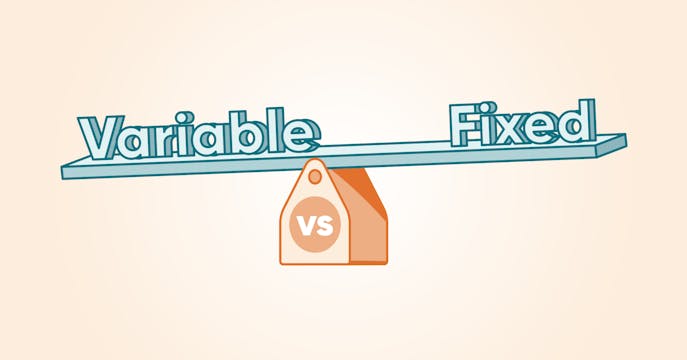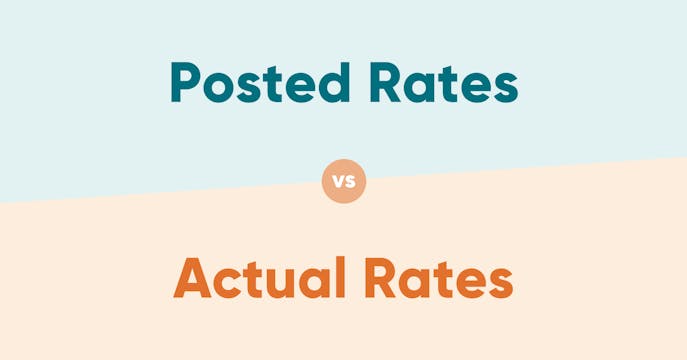Fact: THINK Financial, our CMHC-approved in-house lender, offers adjustable variable-rate mortgages (ARMs).
The interest is compounded semi-annually — even for the lowest open variable rate in Canada offered through our No Commitment® Mortgage.
Can you spot the hidden cost in your mortgage?
Comparing two rates, one may be costing you more.
If your mortgage interest is compounded monthly instead of semi-annually, you're actually paying a higher rate than you thought.
Apples to apples, one rate may not be like the other.
Ever think to ask how often the interest is compounded when looking at mortgage rates?
The answer is in the mortgage fine print, and it's important to know before you sign.
A higher compounding frequency means paying 'interest on interest' more often, increasing the ‘real’ rate you pay despite your contract rate.
Semi-annual compounding is the industry standard for fixed mortgage rates. However, for variable rates (that change according to bank prime rates), some lenders may charge you more often, at a monthly or even weekly frequency — turning a deal into less than a deal.
Let's take a closer look.
What does 'compounding frequency' mean?
For every mortgage, interest is calculated at intervals and added to the principal loan amount. Depending on the interval frequency, extra interest costs can notably accrue over time.
The compounding frequency affects your EAR.
Your EAR (effective annual rate) takes into account your contract mortgage rate calculated at the compound frequency.
How often your variable rate is compounded affects how much interest accumulates on your loan over time. Even with semi-annual compounding, there's a slight increase in your mortgage's EAR compared to your contract rate.
But at a higher frequency (like monthly), the interest is calculated and added to the principal balance more often. You start earning 'interest on interest' earlier, and as your mortgage term progresses, the total interest you're paying on your loan slowly increases. Despite your contract rate, your effective or real annual rate is pushed even higher.
Lenders use a higher compounding frequency to 'plump up' your rate and boost their bottom line.
Semi-annual is considered the 'fair' frequency.
Federally regulated as the standard for fixed-rate mortgages, semi-annual compounding is also considered the 'fair' frequency on variable-rate mortgages.
However, unlike a fixed mortgage rate that doesn't change during your term, variable rates cost more for banks to manage, so the compounding frequency is subject to lender discretion.
When might you run into monthly compounding?
There are two types of variable-rate mortgage products: adjusting or fixed payments.
The fixed-payment kind makes up about 75% of variable-rate mortgages held in Canada. This product is only offered by big banks, and some sneak in monthly compounding to help cover their costs.
Some online-only mortgage platforms may also present a bargain-bin rate upfront but use monthly compounding (and higher pre-penalty payments) in the fine print to make up their margin.
Apples to apples, monthly compounding frequency can cost you more.
| Semi-Annual (standard) | Monthly | |
|---|---|---|
| Effective Rate | 5.06% | 5.12% |
| Monthly Mortgage Payment | $2,326 | $2,338 |
| Mortgage Balance After 5 years | $354,030 | $354,321 |
| Interest Paid (5 years) | $93,615 | $94,622 |
| Interest Paid (25 Years) | $297,926 | $301,508 |
| Monthly Payment Difference | +$12 | |
| Interest Difference (5 Years) | +$1007 | |
| Interest Difference (25 Years) | +$3,582 |
| With a monthly compounding frequency, your mortgage balance is higher after your term (vs. semi-annual), and you pay more interest. Note: Example above is for illustration purposes only. Please check with your True North Mortgage broker for your mortgage details. |
| Semi-Annual (standard) | Monthly | |
|---|---|---|
| Effective Rate | 6.09% | 6.17% |
| Monthly Mortgage Payment | $2,559 | $2,577 |
| Interest Paid (5 years) | $112,900 | $114,361 |
| Mortgage Balance After 5 years | $359,347 | $359,728 |
| Interest Paid 25 Years | $367,767 | $373,160 |
| Monthly Payment Difference | +$18 | |
| Interest Difference (5 Years) | +$1,461 | |
| Interest Difference (25 Years) | +$5,393 |
| With a monthly compounding frequency, your mortgage balance is higher after your term (vs. semi-annual), and you pay more interest. Note: Example above is for illustration purposes only. Please check with your True North Mortgage broker for your mortgage details. |
The higher your rate, the more monthly compounding costs you.
As noted in the effective rate examples above, the higher your contract rate, the more compounding interest monthly (vs. semi-annually) adds up.
- With a 5.0% rate, you'll pay over $1,000 more for a 5-year term
- With a 6.0% rate, you'll pay over $1,400 more for a 5-year term
There's still a difference if your variable rate is lower, say 3.0% (a monthly-compounding effective rate of about 3.04%) — you'll pay around $355 extra in interest over 5 years.
Does weekly interest compounding cost even more?
Some big banks might align the interest compounding frequency with your mortgage payment schedule (e.g. monthly, biweekly, weekly) — though it's roughly the same extra cost as monthly compounding.
The biggest jump is from semi-annual to monthly, but after that, the compounding math peters out. A weekly compounding frequency adds only a nominal increase, which would only be (slightly) apparent at higher mortgage rates.
For example, a 6.0% rate compounded weekly is 6.18% vs. 6.17% for monthly compounding — a 0.01% difference.
An EAR isn't an APR.
Your EAR (effective annual rate) isn't to be confused with your APR (annual percentage rate), which calculates your total mortgage costs.
While the effective rate captures the compounding frequency for your 'real' rate of interest, an APR takes into account all your main mortgage expenses and rebates (such as contract rate, closing costs, and other fees or rebates) for a more accurate number representing all your mortgage costs boiled down to a percentage.
Your mortgage APR is listed in your mortgage commitment letter. Your EAR isn't listed in the commitment, but the compounding frequency is.
When weighing your options, you may be okay with the hidden cost.
Some clients prefer static payments for their variable-rate mortgage despite the potential downsides this product can carry:
- A higher real interest rate if monthly interest compounding is used
- Increasing amortization during times of prime-rate hikes (your amortization adjusts instead of your payments)
- Trigger rates and trigger points lurking in the mortgage fine print (a concern if rates are going up)
When rates go down, your static mortgage payments won't decrease along with rate drops, but some product downsides may become a benefit — for example, if your amortization drops below your original schedule to pay down your mortgage faster.
The apple of our (mortgage) eye.
We put you first to help you find the best rate and mortgage solution, whether your situation is straightforward or your needs are more complex.
Salaried and unbiased, we have the independence to source your perfect fit from several lenders. And yet, we're a unified voice with sound advice that helps you see the fine print and know what you're getting with your lower rate.
Wherever you are in Canada, our apples don't fall far from the tree (all True North brokers are friendly and exceptionally trained). Apply with us online, over the phone, by email, or visit a store near you.
Compare Rates and Save
Various tools and functions of this website perform calculations and provide cost estimates. These tools are designed for illustrative purposes only and make many assumptions that may not reflect all situations. Please use these tools in collaboration with a True North Mortgage agent. True North Mortgage does not guarantee the accuracy, reliability or completeness of these tools or calculations.
We compare lenders, then pass along a volume rate discount.
Great advice grows on trees here

Watch Out For Mortgage Traps
Is your spidey-sense tingling? Watch out! That bargain-bin rate may cost you more later.
Learn More
Should you choose a variable rate in 2025?
How to decide between variable-rate FOMO or JOMO? We can help.
Learn More
Posted Rates vs Actual Rates
Is the rate you see the rate you (can) get? Not always, but here's why.
Learn More

